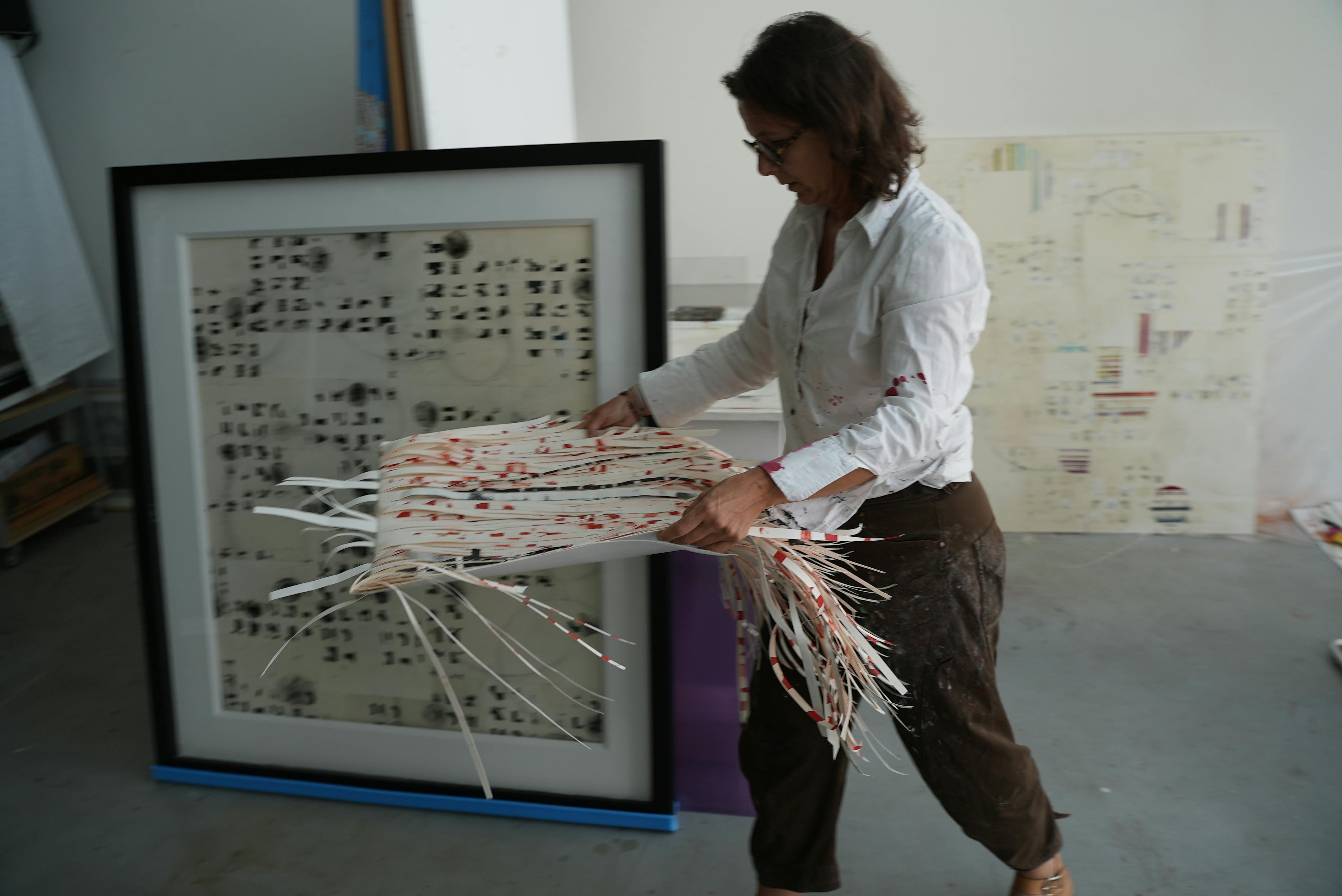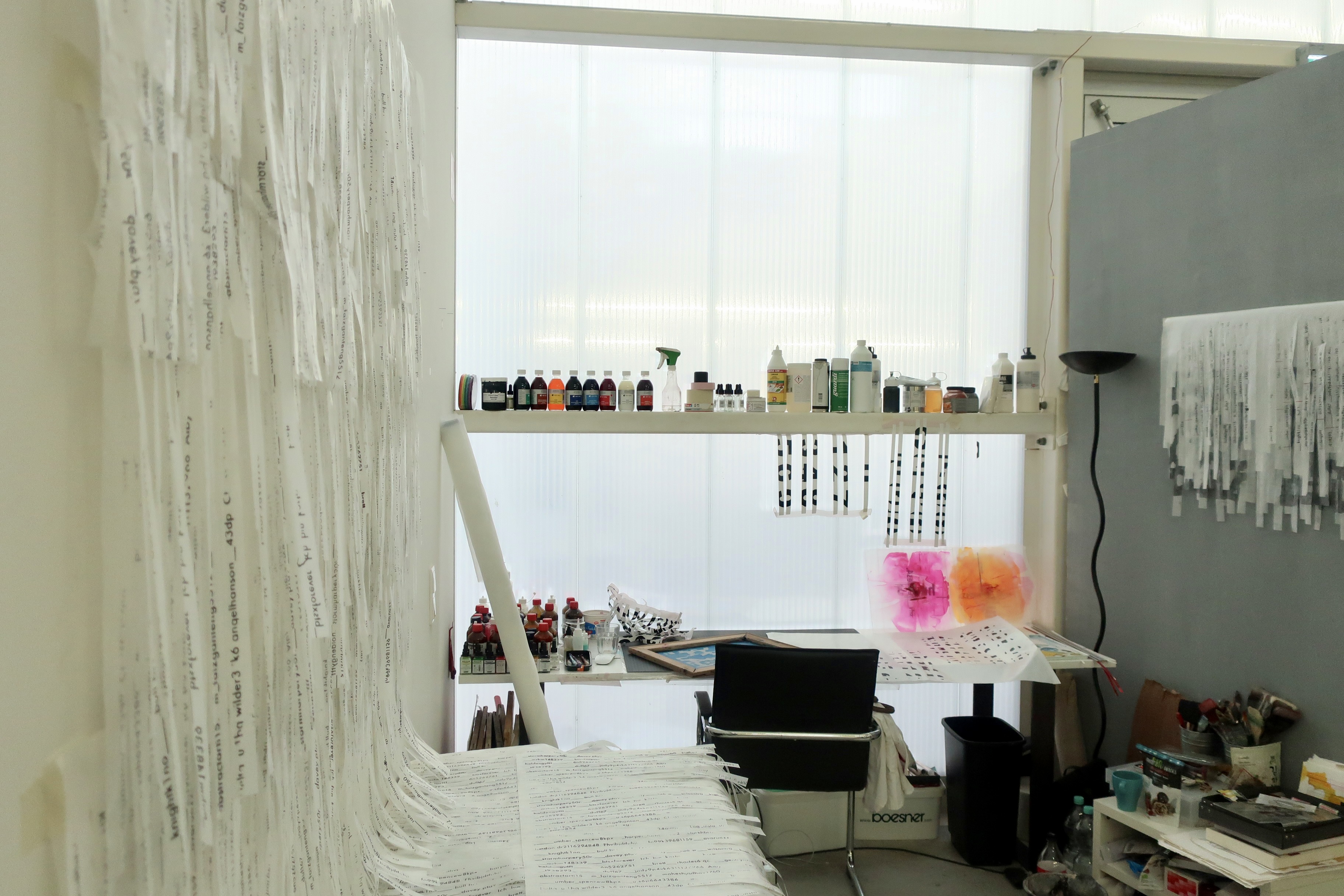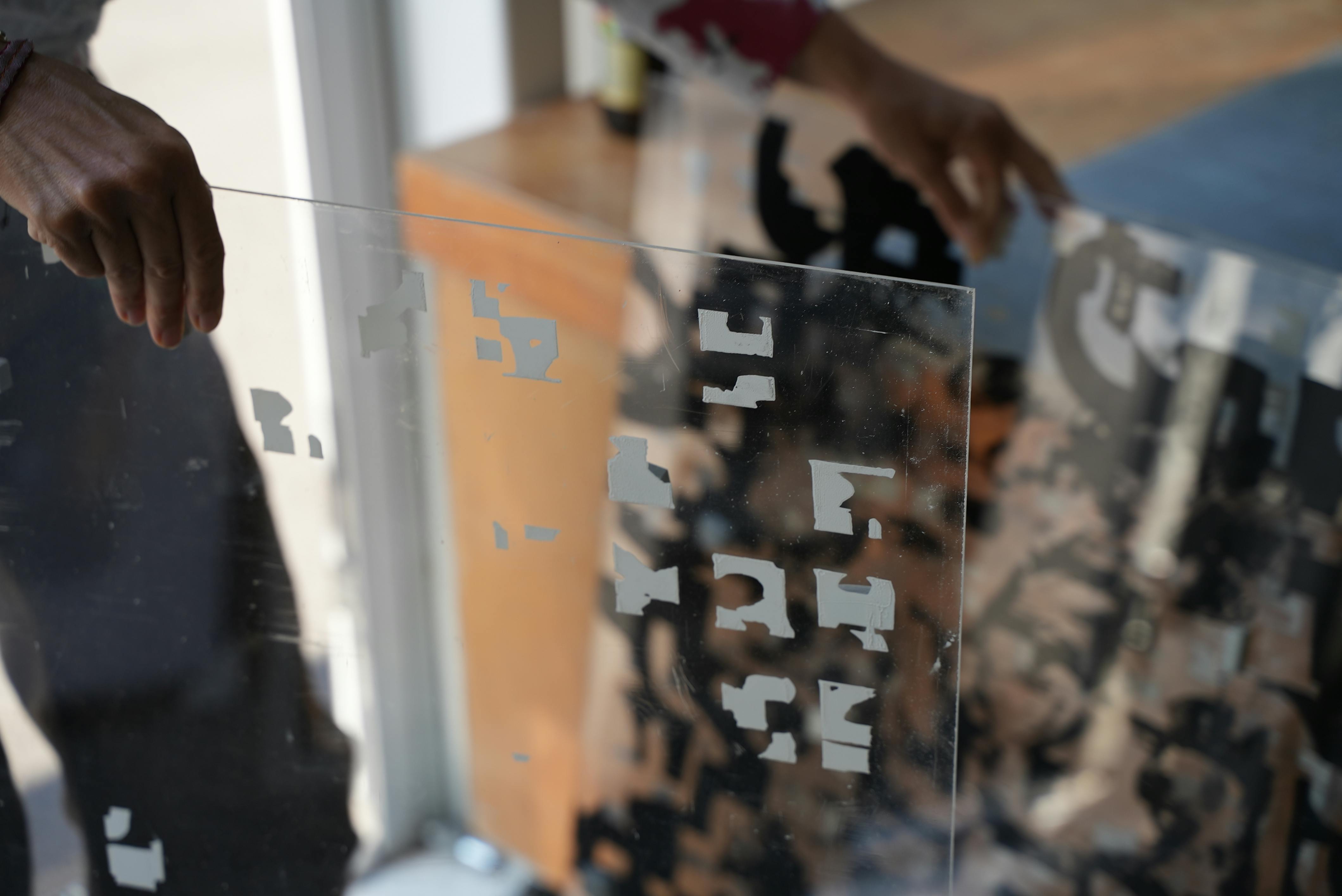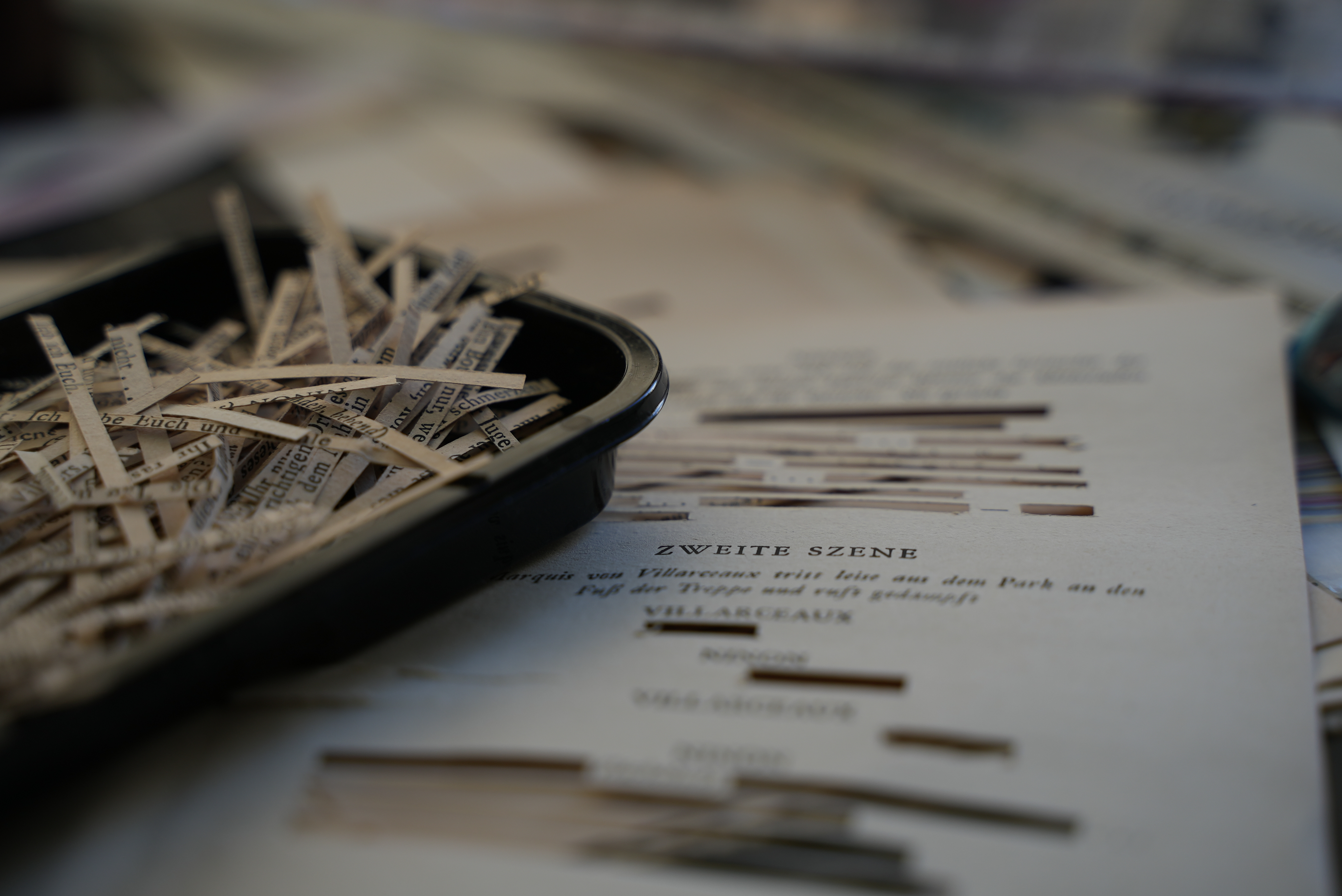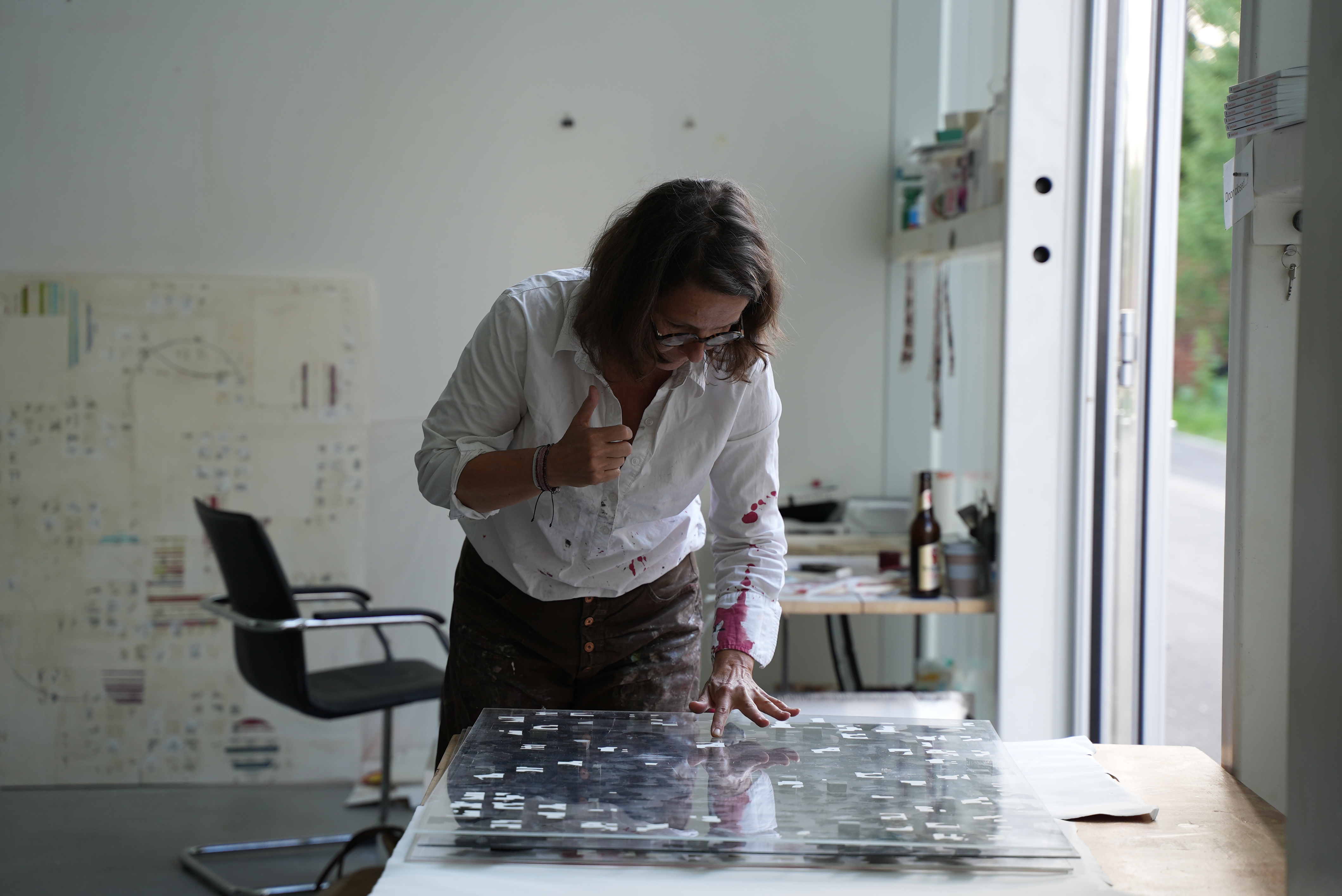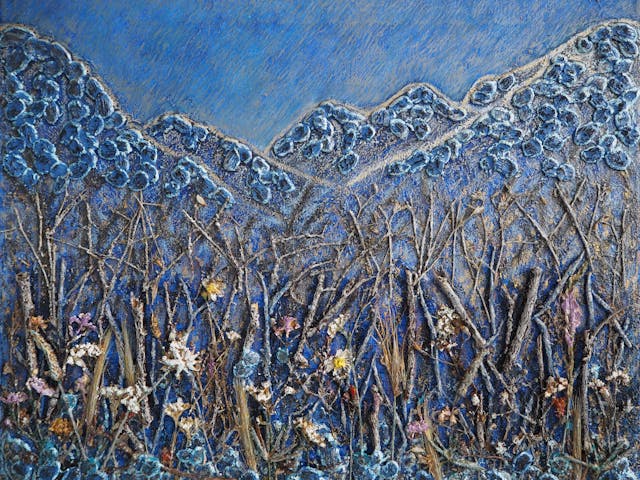Imagine you are at a loss for words and you realize that therein lies a great freedom... The work cycle "Dia-logos" is a study on the representation of the interstice of intuitive thought approach and spoken word!
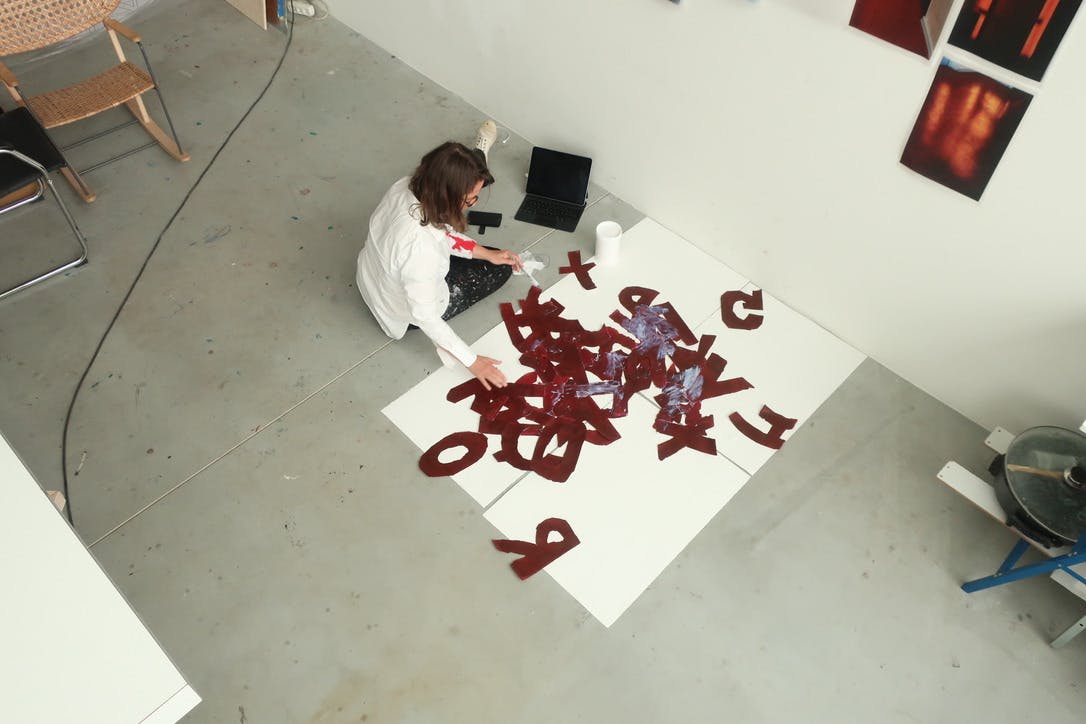
Alexandra at the studio
Dia-logos (Greek: through-words) - An introduction by Dr. Ana Hupe.
We slow our steps to have more time to contemplate the empty white spaces around the black letters, the interdict, the intervening lines, the pauses: commas, exclamations, interrogations, points of omission, silences that speak more than words. The Western world has become accustomed to shouting to assert itself against the noise of information overload. The extended writing of artist Alexandra Winterberg invite us to an opposite movement: a silent conversation, a meditative speech that values listening.
Through her lexicon, two people who do not speak the same language communicate. The body of her work is a dictionary that can describe the distance between one interlocutor and another - Dia-logos, a space where wordless narratives form by themselves, autonomous, independent of the artist's action. Reading is also a physical experience, and Alexandra's works propose a shared reading in space, whose letters are fragmentary traces that have already left the dimension of the book page to enter another landscape that we inhabit. Reading something that one does not understand is like returning to one's childhood. In pre-literacy, we observed the letters that together form words, which in turn form sentences, and all these journeys of meaning passed us by like figures with the meanings of drawings.
With Alexandra, we can do the exercise of returning to that pre-literacy state, of reading her words like a ghostly trail of light that comes into the room in the morning: a ghost, a message to be unraveled. Her spatial writings expose us to other frequencies of feelings, streams of reverberations that pass between bodies, echoes of words, the return of a sound that has never been expressed. A sound that has accumulated in the memory of our cells, where geographies, nationalities and eras intermingle. Alexandra's practice consists in unpacking these histories, which she presents to us as twisted, permuted, analogically coded information that forms a series of echoes.
Alexandra Winterberg at the studio
Coming from Geneva to Berlin must be exciting but also challenging! Can you tell us why you decided to come here and how you experience the time here?
Each city is an open space of projections by everybody. For me, Berlin is the symbol of noticeable dynamics. Where there is dynamism, new movements begin and where there is a break, people are open to new things. This goal motivates and shows a focus that is contagious! Berlin promotes liberating energies! Geneva is a place to live where one can feel the political structures to guarantee this freedom. The local conditions are different, so the international influence is noticeable, but not so tangible.
Each place thus creates its own specific identity, which is expressed through emotional anchoring. The return to specific values are gaining back their roles. Emotional references create regional reactions and actions that could be defined as intuitive “bubbles of emotion”. There are many coexisting bubbles in a city that make up its special character!
Is there a specific environment or material that is essential to your work?
We are all surrounded by our respective social fabric in which the behavioral and emotional space is of essential importance. How can I describe the free space that lies between feeling-thought-expression and action. It is a space of freedom that is available to us for personal self-determination. Quantum research has demonstrated self-determination via mental auto-meditative manipulation. Letters and alphabets are my basis, because we are used to them as a means of expression ... black and white. When, why and what we say is our freedom! Our thinking creates matter by expressing it and putting it into words. Writing and rhythming shows the integration into cultures and historical contexts. Thus, the printing process with ink and India ink is very much in focus!
Are there certain subject areas for you, or even which you come back to regularly in your work?
For me, the overarching theme that connects all my projects is universal writing! It has expressed our roots in global cultures to this day and has developed over thousands of years. With digitization, the typeface is simplified again by creating a global alphabet with emojis and symbols. We use pictograms again and return to the rebus principle. Our alphabets and identities are reflected in QR codes. We type and print it out in “modern hieroglyphs”. We reduce our communicative roots to symbols. The fast pace and their adjustments to new moments connects everyone and everything.
I try to illustrate all processes from digital to analog.Algorithms are percieved today as very abstract, but could be translated in the analog-pictorial language with a repeatedly executed working techniques!
What role does research play in your work?
For me, the research is an absolute source of inspiration, indispensable and triggers a new perspective on the process!
The thought-provoking impulse to deal with palimpsests, for example, has recently exerted a wonderful new influence here in Berlin! I don't want to repeat the act of the palimpsests from the Middle Ages, I want to transfer the process to our day!
In order to save paper in the Middle Ages, old writings were finely sanded down and rewritten! Many old writings were lost in this way and are now being researched (including radio photography) to make them visible again! The result is a structure that gives a glimpse of something legible, but not entirely tangible!
For me, this theory of intertextuality has become a stimulus to apply in our techniques today. Today we no longer grind paper, we erase our writing on the screen! A screenshot replaces the old parchment, and the new text is captured by a new screenshot! Both snapshots on photographic paper exposed one on top of the other, using the technique of photograms, makes it possible to approach the process of “visualizing” the writing layers! Photograms were also known as rayograms, after Man Ray. This technique was playfully used intuitively in Dadaism!
I take my texts from old books with social-societal stories! Dialogues are cut out and exposed in a new modern form and superimposed, resulting in open writing structures after editing!
In summary, one can say that from the research of the topic, through the definition of the associated technology, to the analogous result with the current reference to the present time ... thought processes should be driven!
Can you tell us something about the process of creating your work? How do you start a job and when do you reach that satisfying "I'm done" moment?
Stimulated by statements or research, I try to find the closest possible form of artistic expression! The work process often begins with a digital concept, which is implemented analogously! The corresponding pictorial technique should reflect the psychological processlike a “mirror” ! When I project a meaning onto something, it is “projected” via light, photo or print. If something should be said about the duplication or distribution, I like to work with printing techniques. Every technique of painting, drawing, printing or serigraphy has a psychological anchor.
As an example, I could cite that it was important for me to express my perception and understanding of our environment. Our ancestry can be determined by dialects and expressions.
I directly implement this re-“mirroring” of our living conditions by recording words and letters mirror-inverted! This personal touch and change of the usual typeface to the illegible acts like an embossing of a DNA! This repetition of the illegible letters forms an rhythmic structure that creates an image of a personal moment.
Analyzing and creating in this way is a never-ending process. Of course there are stages of work that I define as a statement in itself, as fully worked out! Since this process started years ago, I have a few completed cycles in the studio!
Are there influences from other artists in your work?
My studies in architecture and interior design naturally put the school of vision and social analysis in the foreground. Walter Gropius, Josef Albers, Le Corbusier and Adolf Loos are of course to be mentioned here. The overarching interdisciplinary aspect of creation is very important to me. Every statement should be worked out artistically using the closest language of form. Anthroposophic (eurythmy) approaches by Rudolf Steiner are not just holistic theoretical approaches but roots of rethinking.
Hilma Af Klint, with her theosophical background, gets her due place today with her revolutionary approaches to signs and punctuation at the time. In studies for my work, I was of course very fascinated by artists* such as Man Ray, Salvadore Dali, Jaques Villeglé, Meret Oppenheimer, Bernar Venet, Hannah Darboven, Vera Mollnar and Heinz Gappmeier, and André Thomkins.
Some artists have clear ideas about what and how viewers should experience their work. What do you make of it?
Of course I wish to give stimulating impulses for our impressions and expressions! The question of whether a true exchange takes place in a communication is very important to me, as it allows the degree of freedom between thinking and speaking the necessary space. The ability to be open to new situations, to have one's own position questioned, sets in motion a dynamic of change. The big and whole vision of the situation is important and helps a lot to stop seeing limitations as obstacles. Emotions are based on lived and already integrated behavior patterns, they reflect situational sensitivities and longings. Empathic resonance is important to promote the development of new integrations of ideas, then black and white thought patterns can dissolve. Fixed structures become penetrable again for new visions.
What about titles? How do you deal with titles in your work?
My work always reveals itself differently at the moment of observation and should not block any projections with titles. It should enable perspectives that want to use the freedom! Some titles are created directly and have a trend-setting effect, while others offer a completely open system.
How do you feel about work-life balance?
My work and life balance are not necessarily separate for me. My ideas come from talking, listening and exchanging ideas with my surroundings. I love to surround myself with people and hear their perspectives. Laughing and crying go together and add value. Friends and family are very important to me. The movement outdoors is a great stimulus for processing and serves as a balance. Thinking begins in the knee! (Joseph Beuys quote) The head clears and the perseverance in execution becomes more patient.
Next steps - what's next for you?
For me, the development of multidimensional space is the next step. We are surrounded by so many impressions that we learn to perceive and recognize in a more subtle way. These dimensions give us a new approach to emotions. There are not always words for what we feel! Light and sound are the ultimate carriers of memories. "Music says more than a thousand words" The sense of smell and taste bring the past directly into the present! Senses are memories and bridges at the same time!
Solo exhibition at coGalleries - Berlin Mitte from
24.06-30-06.22
Opening 24.06.22 - 6-9pm
Torstr. 170, 10115 Berlin
Opening of the gallery from Monday - Saturday from 13-6pm, appointments can be scheduled at different times.

